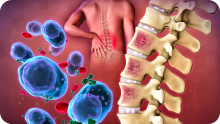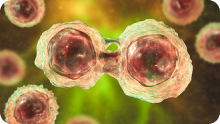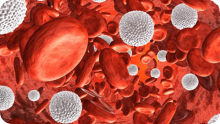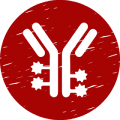
what to look out for?

How to assess patients who have progressed?

therapy in multiple myeloma:
When why and how?


multiple myeloma
New drugs are continually being studied in clinical trials as experimental therapies.
Sometimes participating in a clinical trial can be a way to get access to new treatments especially if your treatment success rates have been low. Your doctor will be able to tell you if there are any clinical trials you may be eligible for.
Some of the emerging therapies fall under the following classes of multiple myeloma therapy:

Novel mechanisms of action:
These drugs target proteins involved in cell growth and division. The target protein may be specific to myeloma cell or common to all cells. Examples include histone descetylase inhibitors (HDAC inhibitors) and nuclear export inhibitors.

Newer immunomodulatory agents:
These work by activating certain immune cells, preventing growth signals to cancer cells or directly killing myeloma cells.

Naked antibodies:
These recognize and target a specific protein on the surface of myeloma cells which enables the immune system to identify them and eliminate the targeted myeloma cells

Antibody-drug conjugates:
In these type of drugs an antibody is bound to a cancer drug or a toxin. The antibody part of the conjugate binds to a special protein on the surface of a myeloma cell called B-cell maturation antigen (BCMA), marking the myeloma cell for destruction by the toxin.

Bi-specific antibodies:
In these types of drugs two antibodies are fused together. One antibody binds to the BCMA protein on myeloma cells while the other binds to a protein called CD3 in T-cells. T-cells are immune cells which when activated can kill myeloma cells that have been marked. These have not been approved for multiple myeloma treatment yet.

CAR-T-cell therapy:
In Chimeric antigen receptor-T cell (CAR T) therapy, your T-cells will be collected from the blood and modified to recognize and target a particular protein on the surface of the cancer cells. They will then be reintroduced back into your body to attack and kill the cancer cells. These have been recently approved by the FDA.

Immunocytokines:
A first-in-class fusion protein that combines modified interferon alpha 2b to an anti-CD38 monoclonal antibody. These act by direct antiproliferative effects on myeloma cells as well as direct and indirect immune cell activation.
References:
- “Clinical Trials and New Therapies for Multiple Myeloma | The MMRF.” Themmrf.Org, https://themmrf.org/multiple-myeloma/treatment-options/clinical-trials-and-experimental-therapies/. Accessed 7 Apr. 2022.
- “Multiple Myeloma - Latest Research.” Cancer.Net, 25 June 2012, https://www.cancer.net/cancer-types/multiple-myeloma/latest-research.
- Vogl DT, et al. Modakafusp Alfa (TAK-573), an Immunocytokine, Shows Clinical Activity in Patients with Relapsed/Refractory Multiple Myeloma; Updated Results from a First-in-Human Phase 1 Study. American Society of Hematology Annual Meeting and Exposition Dec 2021. Oral session: 898.







